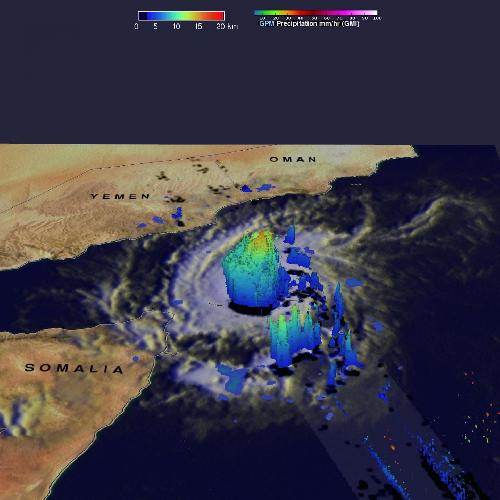One week ago to the day Cyclone Chapala, the first Category 1 cyclone to strike Yemen in recorded history made landfall in Yemen, then a second tropical cyclone named Megh made landfall. The Global Precipitation Measurement mission or GPM satellite provided a look at rainfall rates and totals dropped by the historic double tropical cyclones.
Chapala brought over a year's worth of rain and flooding to the south-central coast. Megh made landfall just to the northeast of the coastal city of Aden, which is further west than where Chapala made landfall, and only as a tropical storm.
There are, however, several similarities between the two storms. Megh formed in almost the exact same spot in the central Arabian Sea as Chapala. It likewise intensified into a powerful cyclone, reaching Category 3 intensity with maximum sustained winds estimated at 110 knots (~127 mph) by the Joint Typhoon Warning Center (JTWC) as it tracked generally westward towards the island of Socatra.
 On Nov. 8 GPM saw intense rain rates of up to 100 mm per hour (~4 inches per hour) in the southern half of the eyewall surrounding Megh's center. Credit: Credits: NASA/JAXA/SSAI, Hal Pierce
On Nov. 8 GPM saw intense rain rates of up to 100 mm per hour (~4 inches per hour) in the southern half of the eyewall surrounding Megh's center. Credit: Credits: NASA/JAXA/SSAI, Hal Pierce
Although Chapala reached Category 4 intensity with sustained winds estimated at one time at 135 knots (~155 mph), both storms resulted in several fatalities on Socatra. Chapala dumped heavy rains on the island as it passed slightly to the north and was blamed for 11 fatalities, while Megh, though weaker, was reported to have caused more damage as the center passed right along the northern coast of Socotra and is being blamed for 6 fatalities.
GPM is a joint missions between NASA and the Japanese space agency JAXA.GPM captured rainfall date on Megh on Sunday, November 8 at 12:31 UTC (7:31 a.m. EST) just after the center had passed over Socotra. Data of rain rates were derived from the GPM GMI (in the outer swath) and DPR instrument (the inner swath).
GPM data showed Megh's rain field was rather small with most of the rain occurring in the southern half of the storm and not too far from the center. However, there are very intense rain rates of up to 100 mm per hour (~4 inches per hour) in the southern half of the eyewall surrounding the storm's center. These rain rates are associated with an area of deep convection
At NASA's Goddard Space Flight Center in Greenbelt, Maryland, GPM data was used to create a 3-D rendering of Megh constructed from the DPR instrument data. At the time GPM passed overhead, Megh's maximum sustained winds were estimated at 100 knots (~115 mph) by JTWC, making it a Category 3 cyclone. After passing over Socotra, Megh continued to weaken as it continued westward before making landfall as a tropical storm on the southern coast of Yemen.
Unlike Chapala, which brought heavy rains to Socotra and south-central Yemen, IMERG (Integrated Multi-satellitE Retrievals for GPM) rainfall estimates associated with the passage of Megh for the period from November 5 to 10, 2015 show much lighter amounts.
Chapala's rainfall were generally 5 to 6 inches or less. Socotra, which was estimated to have received between 12 and 20 inches of rain from Chapala, appears to have received mostly 3 inches or less from Megh. Rainfall amounts over Yemen are also much less with Megh, generally less than 2 inches with only isolated higher amounts. The highest rainfall totals from Megh over land appear over the northeast tip of Somalia where as much as 10 inches may have fallen.
source: NASA/Goddard Space Flight Center